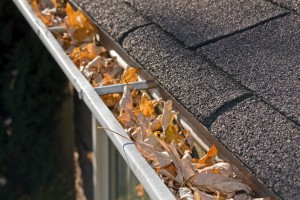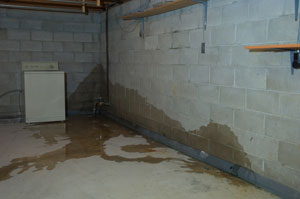
The cause of a wet or damp basement can be signs of a potential bigger issue. readily apparent and corrected with the proper fix. Here are some probable causes and possible solutions:
Problem: The source of water in the basement cannot be located.
Solution: To determine whether the water is seeping in from the outside or condensation inside, tape a twelve-inch square of aluminum foil to a wall that is prone to dampness, sealing all four sides as airtight as possible. In a day or two, if the side of the foil that was against the wall is wet, the problem is seepage. If the outside is wet, it’s condensation.
Problem: Lawns that are flat or slope toward the house allow rain and melting snow to drain down against basement walls. Water enters through cracks or other openings in the walls and causes wet spots on the walls or standing water on the floor.
Solution: You’ll need to slope the ground away from the outside foundation (about one inch per foot). Extend the slope for at least ten feet. Seed it with a good lawn grass. Sodding is a common practice and prevents the washing away of newly graded areas during heavy rains. Where a large area of land slopes toward the house, surface drainage should be intercepted and redirected some distance from the house. You’ll need to dig a shallow, half-round drainage ditch or depression in order to route the water around the house. Sod the ditch or plant grass in it. If even a shallow ditch is not preferred, drainage tiles, with one or more catch basins at low spots, may be installed.
Problem: Defective, clogged, or nonexistent gutters and downspouts allow roof water to form puddles, or wet the soil near or against basement walls, and enter through cracks or openings in the concrete or concrete block foundation wall.
Solution: Install gutters and downspouts wherever needed. Keep them free of debris. Where leaves and twigs from nearby trees may collect in a gutter, install a basket-shaped wire strainer over the downspout outlet or place screening across the length of the gutter. Repair gutters and downspouts as soon as the need appears.
To prevent concentration of water at the point of discharge, use a concrete gutter or splash block to carry the water away at a slope of one inch per foot. Also, consider extending downspouts from rain gutters away from the outside foundation. Roof water can also be piped underground to a storm drain, dry well, or surface outlet, fifteen feet or more from the house.
Problem: Dense shrubbery and other plantings around the basement walls are preventing good ventilation.
Solution: Trim the heavy growths of shrubbery so that soil gets more sunlight and dries quicker. When digging up the plants, remove any pieces of masonry, mortar, or other material buried near the house after the basement was excavated.
Problem: Unprotected basement window wells collect rainwater during heavy storms, permitting water to seep in around window frames and below windows.
Solution: Windows or parts of windows below grade should be protected by metal or masonry window wells, with bottoms consisting of gravel to permit good drainage. Clear plastic bubbles are available to cover the entire window well like an awning.

Problem: Moisture from the atmosphere produces condensation on cool surfaces in the basement, particularly walls, floors and cold water pipes.
Solution: Start by insulating the water pipes. Promote good ventilation – sunlight and free movement of air can quickly dry out a basement. Ventilation should be regulated according to the weather conditions. During hot, humid weather or long rainy spells, windows should be closed because the outside air will probably contain more moisture than the basement air. Heat the basement during the winter. During hot weather, use air conditioning to cool and dehumidify the air.
Problem: Leaky plumbing or other sources of moisture, (such as clothes hung to dry on basement lines) increase humidity in the air, causing condensation.
Solution: Repair plumbing promptly, open windows or dry clothes in an automatic dryer vented outdoors. If the problem persists, experiment with using a large-capacity dehumidifier to eliminate condensation. Try borrowing one from a friend or neighbor first.
Robbins and Co. are Foundation Repair and Drainage Solution professionals in business since 1952. CONTACT US today at 206.244.1023 for a no-cost consultation or just to ask us a question. We look forward to talking with you.

0 Comments